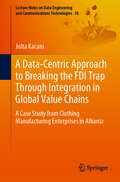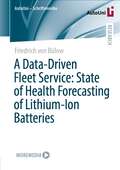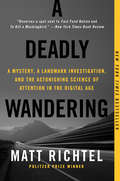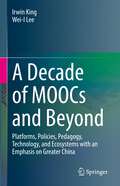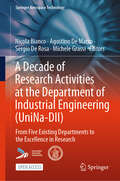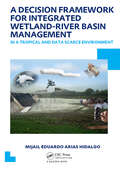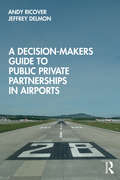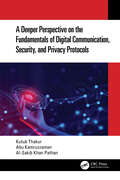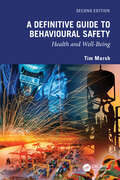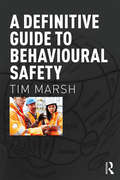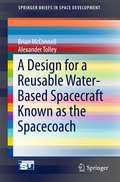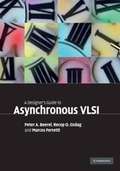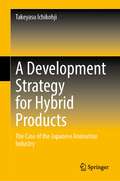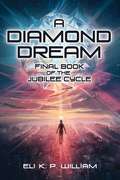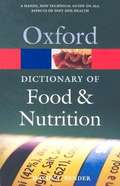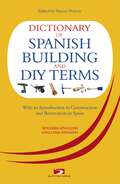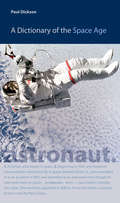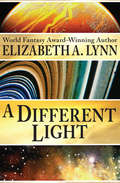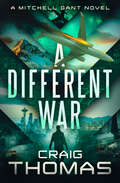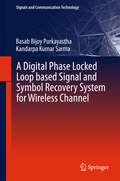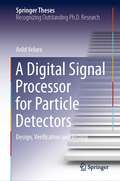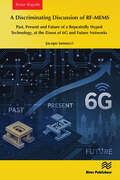- Table View
- List View
A Dangerous Master: How to Keep Technology from Slipping Beyond Our Control
by Wendell WallachWe live in an age of awesome technological potential. From nanotechnology to synthetic organisms, new technologies stand to revolutionize whole domains of human experience. But with awesome potential comes awesome risk: drones can deliver a bomb as readily as they can a new smartpho≠ makers and hackers can 3D-print guns as well as tools; and supercomputers can short-circuit Wall Street just as easily as they can manage your portfolio. One thing these technologies can’t do is answer the profound moral issues they raise. Who should be held accountable when they go wrong? What responsibility do we, as creators and users, have for the technologies we build? In A Dangerous Master, ethicist Wendell Wallach tackles such difficult questions with hard-earned authority, imploring both producers and consumers to face the moral ambiguities arising from our rapid technological growth. There is no doubt that scientific research and innovation are a source of promise and productivity, but, as Wallach, argues, technological development is at risk of becoming a juggernaut beyond human control. Examining the players, institutions, and values lobbying against meaningful regulation of everything from autonomous robots to designer drugs, A Dangerous Master proposes solutions for regaining control of our technological destiny. Wallach’s nuanced study offers both stark warnings and hope, navigating both the fears and hype surrounding technological innovations. An engaging, masterful analysis of the elements we must manage in our quest to survive as a species, A Dangerous Master forces us to confront the practical--and moral--purposes of our creations.
A Data Engineering Approach to Wave Scattering Analysis with Applications in Radar, Sonar, Medical Diagnostics, Structural Flaw Detection and Intelligent Robotics
by Mark K. HindersComprehensive resource exploring how recent advancements in computational capabilities open doors to new applications in wave scattering A Data Engineering Approach to Wave Scattering Analysis: with Applications in Radar, Sonar, Medical Diagnostics, Structural Flaw Detection and Intelligent Robotics applies scattering analysis to many applications including radar, sonar, medical diagnosis, intelligent robotics, and more, enabling readers to implement new and better measurements with both novel instrumentation and artificial intelligence that automates the interpretation of various (and multiple) imaging data streams. Composed of 10 chapters, this book brings together separate scientific topics that share a common basis of knowledge and their unchanged mathematical techniques to ensure successful results. Through periodic exercises, this book reinforces the importance of revisiting derivations and reproducing established results. It also delves into the individuals who shaped scientific methods and technologies, exploring 81 notable names and providing insights into their professional journeys. Classic results from scattering are included in each chapter, and rather than simply pasting in plots from classic papers, these results have largely been reproduced for a more coherent reader experience. Written by an established academic in the field, A Data Engineering Approach to Wave Scattering Analysis: with Applications in Radar, Sonar, Medical Diagnostics, Structural Flaw Detection and Intelligent Robotics includes information on various topics: Field equations, covering strain as a dimensionless measure of deformation, generalized Hooke’s Law, and elastic and acoustic wavesReflection and refraction, covering reflection from a free surface and surface waves as well as the wave model of acoustic microscopyGuided waves, covering torsional modes, longitudinal waves, and flexural waves in rods, as well as data engineering for lamb wave tomographyInverse scattering, covering wavelet transforms and fingerprinting as well as applications of wavelet fingerprints such as roof fall detection A Data Engineering Approach to Wave Scattering Analysis: with Applications in Radar, Sonar, Medical Diagnostics, Structural Flaw Detection and Intelligent Robotics is an essential up-to-date reference on the subject for researchers interested in radar, sonar, medical imaging, structural health monitoring, manufacturing process control, and autonomous vehicles, as well as upper-level undergraduates and graduate students in related programs of study.
A Data-Centric Approach to Breaking the FDI Trap Through Integration in Global Value Chains: A Case Study from Clothing Manufacturing Enterprises in Albania (Lecture Notes on Data Engineering and Communications Technologies #50)
by Jolta KacaniThis book reveals the hidden potential of emerging economies to become the new industrial hubs in existing global value chains. Pursuing a data-centric approach, it investigates the presence of foreign direct investment as an instrument for emerging economies to promote active participation in global value chains. This approach is based on time series analyses conducted at the national and industry level, and on datasets retrieved from international databases such as EORA, ICIO, and World Integrated Solutions. The outcomes of robust statistical models indicate that export-related innovations can improve trade openness and transform emerging economies into active players in global value chains. Researchers, developers, and professionals in the field will find a comprehensive and self-contained guide to the topic.
A Data-Driven Fleet Service: State of Health Forecasting of Lithium-Ion Batteries (AutoUni – Schriftenreihe #170)
by Friedrich von BülowGiven the limitations of state-of-the-art methods, this book presents a state of health (SOH) forecasting method that is suitable for lithium-ion battery (LIB) systems in real-world battery electric vehicle operation. Its histogram-based features can capture the higher operational variability compared to constant and controlled laboratory operation. Also, the transferability of a trained machine learning model to new LIB cell types and new operational domains is investigated. The presented SOH forecasting method can be provided as a cloud service via a web or smartphone app to fleet managers. Forecasting the SOH enables fleet managers of battery electric vehicle fleets to forecast and plan vehicle replacements.
A Deadly Wandering
by Matt RichtelA landmark exploration of the vast and expanding impact of technology, rivetingly told through the lens of a deadly collisionOne of the year's most original and masterfully reported books, A Deadly Wandering by Pulitzer Prize-winning New York Times journalist Matt Richtel interweaves the cutting-edge science of attention with the tensely plotted story of a mysterious car accident and its aftermath to answer some of the defining questions of our time: What is technology doing to us? Can our minds keep up with the pace of change? How can we find balance? Through Richtel's beautifully constructed narrative, a complex and far-reaching topic becomes intimate and urgent--an important call to reexamine our own lives.On the last day of summer, an ordinary Utah college student named Reggie Shaw fatally struck two rocket scientists while texting and driving along a majestic stretch of highway bordering the Rocky Mountains. Richtel follows Reggie from the moment of the tragedy, through the police investigation, the state's groundbreaking prosecution (at the time there was little precedent to guide the court), and ultimately, Reggie's wrenching admission of responsibility. Richtel parallels Reggie's journey with leading-edge scientific findings regarding human attention and the impact of technology on our brains--showing how these devices, now thoroughly embedded into all aspects of our lives, play to our deepest social instincts and prey on parts of the brain that crave stimulation, creating loops of compulsion, even addiction. Remarkably, today Reggie is a leading advocate who has helped spark a national effort targeting distracted driving, and the arc of his story provides a window through which Richtel pursues actionable solutions to help manage this crisis individually and as a society. A propulsive read filled with fascinating scientific detail, riveting narrative tension, and rare emotional depth, A Deadly Wandering is a book that can change--and save--lives.
A Decade of MOOCs and Beyond: Platforms, Policies, Pedagogy, Technology, and Ecosystems with an Emphasis on Greater China
by Irwin King Wei-I LeeThis book is an academic publication about the global development of massive open online courses (MOOCs) and major MOOC platforms worldwide in the past decade, as well as the outlook of MOOCs in the future, with an emphasis on Greater China. The book also discusses the upsurge of the demand for online learning and MOOCs during the COVID-19 pandemic.The book is divided into three main parts - Part I: Overview of MOOCs introduces the origin and history of MOOCs and the development of MOOC platforms in Greater China and the global context; Part II: Key Issues discuss the MOOC policies, innovative pedagogy, technology, and ecosystems worldwide; and Part III: Beyond MOOCs probes into the roles and benefits of MOOCs in times of crises, as well as the outlook of MOOCs in the future. In terms of topic diversity, the book contains a comprehensive investigation of the past and latest MOOC developments, extracting and elaborating on relevant information regarding platforms, policies, pedagogy, technology, and ecosystems. Subsequently, in-depth analyses of MOOC data are utilized to deduce the current trends related to the MOOC movement and to extrapolate the likeliest direction of development for MOOCs in the years to come. The book can inform policymakers, education institutions, course instructors, platform developers, investors, researchers, and individual learners of MOOCs about critical information on the present and future of MOOC development, assisting them in making crucial decisions on what initiatives can optimize their advantages in the sector.
A Decade of Research Activities at the Department of Industrial Engineering: From Five Existing Departments to the Excellence in Research (Springer Aerospace Technology)
by Sergio De Rosa Nicola Bianco Agostino De Marco Michele GrassiThis open access book celebrates the decennial of the Department of Industrial Engineering of Università di Napoli Federico II, Italy. It covers the main research achievements developed at the department in the fields of aerospace, marine, energy, statistical, mechanical and management engineering. Five pre-existing departments merged in 2013, and the research results are here summarized to certify how important it was to join skills, expertise, and projects. The industrial engineering area is huge, but it is now dominated by the need to conceive and analyze new solutions, human and climate oriented to face with the actual challenges which dictate the new paradigm, which evolved from “is it feasible?” to “is it compatible with the environment and the human beings?”. There is still a lot to do, but the contents of this book demonstrate that the first steps have been done. All the researchers of the department have contributed to this book, more than 140 authors, and thus, it isthe collective outcome of the path they were able to perform all together, including administrative officers and technicians. It highlights the international relevance and multidisciplinarity of research at the university as well as the planned research lines for the next years.
A Decision Framework for Integrated Wetland-River Basin Management in a Tropical and Data Scarce Environment: UNESCO-IHE PhD Thesis (IHE Delft PhD Thesis Series)
by Mijail Eduardo HidalgoTraditionally, wetlands were considered separately from river basin systems. However, nowadays it is becoming common practice to follow an integrated approach in wetland-riverine watershed analysis and management. Such approach requires not only adequate representations of all relevant bio-physical parameters, but also of socio-political and econom
A Decision-Makers Guide to Public Private Partnerships in Airports
by Jeffrey Delmon Andy RicoverAirport development is critical to economic growth and poverty reduction. This book will help decision-makers assess whether Public Private Partnerships (PPP) might be a viable option to meet their airport development requirements. It walks the reader through the airport PPP process, from early preparation to bringing the project to market and managing the project during implementation. The book will help eradicate misconceptions about the role of the private sector in airport infrastructure. A Decision-Makers Guide to Public Private Partnerships in Airports provides an essential guide for those in a position to make decisions linked to airport development, to their advisers, their staff and also to students wishing to understand airport PPP.
A Deeper Perspective on the Fundamentals of Digital Communication, Security, and Privacy Protocols
by Al-Sakib Khan Pathan Kutub Thakur Abu KamruzzamanThis book, divided into three parts, describes the detailed concepts of Digital Communication, Security, and Privacy protocols. In Part One, the first chapter provides a deeper perspective on communications, while Chapters 2 and 3 focus on analog and digital communication networks. Part Two then delves into various Digital Communication protocols. Beginning first in Chapter 4 with the major Telephony protocols, Chapter 5 then focuses on important Data Communication protocols, leading onto the discussion of Wireless and Cellular Communication protocols in Chapter 6 and Fiber Optic Data Transmission protocols in Chapter 7. Part Three covers Digital Security and Privacy protocols including Network Security protocols (Chapter 8), Wireless Security protocols (Chapter 9), and Server Level Security systems (Chapter 10), while the final chapter covers various aspects of privacy related to communication protocols and associated issues. This book will offer great benefits to graduate and undergraduate students, researchers, and practitioners. It could be used as a textbook as well as reference material for these topics. All the authors are well-qualified in this domain. The authors have an approved textbook that is used in some US, Saudi, and Bangladeshi universities since Fall 2020 semester – although used in online lectures/classes due to COVID-19 pandemic.
A Definitive Guide to Behavioural Safety: Health and Well-Being, Second Edition
by Tim Marsh‘Behavioural safety’ or behaviour-based safety (BBS) has been around as a concept for several decades and is commonly held to mean directly tackling the frontline behaviours that lead to incidents and injury. Unfortunately, virulent criticism of some approaches of BBS frequently generalises to all others, so that commentators don’t know if they are arguing or agreeing. This book aims to cut through the waffle to be the one-stop guide to all the core theories and principles that underpin behaviour-based safety. In this second edition, internationally acclaimed behavioural safety expert Tim Marsh leads the reader through the three main strands: The awareness approach, the ‘walk-and-talk’ approach, and the Six-Sigma safety or the Deming-inspired ‘full’ approach that covers the systemic approach to safety observation, measurement, intervention, and analysis, but also incorporates emotional intelligence training aimed at enhancing supervisor-worker trust and communication more generally. Updated to reflect systemic changes due to the COVID-19 pandemic and featuring a brand-new chapter on well-being that discusses the massive changes in thinking about the interaction of culture and personal safety that have occurred since the previous edition was published. This book allows the reader to set up an ambitious and wide-ranging behavioural safety programme from scratch or refresh their current approach. Written by one of the world’s leading BBS experts, including leading the first major research project on the applied use of BBS outside of the US, based on the author’s experiences with more than 400 organisations Delivered in an accessible and popular writing style that simplifies complex theory and arguments in a user-friendly way, plus features end-of-chapter checklists to underpin learning Possesses a post-COVID focus, bringing behavioural safety into the 2020s, and covers the growing concept of well-being in a brand-new chapter. The title features end-of-chapter checklists to confirm understanding of the concepts. A Definitive Guide to Behavioural Safety is the go-to book for any practicing occupational health and safety professional.
A Definitive Guide to Behavioural Safety: The Definitive Guide
by Tim MarshThis book makes the case that far too much work undertaken under the banner of ‘behavioural safety’ is overly person-focused. ‘If you can walk on hot coals, you can do anything – so be safe’ needs to be dismissed out of hand, but also more advanced techniques based on coaching and empowerment fail to reflect the fact that, as ‘Just Culture’ models show, the great majority of causes of unsafe behaviour are environmental. Our methodologies mustn’t focus on the person with an open mind that there may be an underlying root cause; they must start from the statistically proven assumption that there is an underlying cause. This shift in mindset has a profound impact on the type of methodologies we must lead with, how they are used, how they are perceived, and last but certainly not least, their efficacy. A Definitive Guide to Behavioural Safety is a one-stop guide to all of the core theories and principles that underpin behaviour-based safety. All front-line behaviours that lead to incidents and injury are covered by the term behavioural safety, and getting to grips with the behaviours that might lead people to engage in unsafe or risky behaviour is crucial to prevention. In this book, internationally acclaimed behavioural safety expert Tim Marsh leads the reader through the three main strands: The awareness approach. The walk-and-talk approach. The Six Sigma safety or the Deming-inspired ‘full’ approach. Going through the very latest innovations in the field, the book covers the systemic approach to safety observation, measurement, intervention and analysis, but also incorporates emotional intelligence training aimed at enhancing supervisor–worker trust and communication more generally. A Definite Guide to Behavioural Safety is a perfect guide for any professional, whether you’re aiming to set up an ambitious and wide-ranging behavioural safety programme from scratch or you’re looking to refresh or extend an existing approach.
A Design for a Reusable Water-Based Spacecraft Known as the Spacecoach (SpringerBriefs in Space Development)
by Brian Mcconnell Alexander TolleyBased on components already in existence, this manual details a reference design for an interplanetary spacecraft that is simple, durable, fully reusable and comprised mostly of water. Using such an accessible material leads to a spacecraft architecture that is radically simpler, safer and cheaper than conventional capsule based designs. If developed, the potential affordability of the design will substantially open all of the inner solar system to human exploration. A spacecraft that is comprised mostly of water will be much more like a living cell or a terrarium than a conventional rocket and capsule design. It will use water for many purposes before it is superheated in electric engines for propulsion, purposes which include radiation shielding, heat management, basic life support, crew consumption and comfort. The authors coined the term "spacecoaches" to describe them, as an allusion to the Prairie Schooners of the Old West, which were simple, rugged, and could live off the land.
A Designer's Guide to Asynchronous VLSI
by Peter A. Beerel Recep O. Ozdag Marcos FerrettiBypass the limitations of synchronous design and create low power, higher performance circuits with shorter design times using this practical guide to asynchronous design. The fundamentals of asynchronous design are covered, as is a large variety of design styles, while the emphasis throughout is on practical techniques and real-world applications.
A Development Strategy for Hybrid Products: The Case of the Japanese Animation Industry
by Takeyasu IchikohjiThis is the first book that deals with technological innovation in Japanese animation industry from a management perspective. In reviewing prior research and explaining the history of the technology, the author raises the difficulty of dealing with new technologies. In particular, the focus is on systems that combine analog technology (drawing by hand) and digital technology (3D computer graphics or 3DCG) to create a product. This combined technology is referred to as "hybrid technology" in this book, and the development and management of "hybrid products" using this technology are studied. The study was conducted in two stages. The first stage was to determine the engineers’ (animators’) perception of hybrid technology. The results showed that in terms of potential, the hybrid technology of hand-drawn animation combined with 3DCG was rated more highly by engineers than hand-drawn alone. However, in terms of the assessment at that time, hybrid technology was rated higher than 3DCG alone but lower than hand-drawn. Therefore, it was assumed that hybrid technology, while useful, would pose challenges with respect to systematic implementation. The second stage was the development management of hybrid products. The results showed that the "adaptive engineer," who openly accepts other new technologies in the early stages of their emergence contributed to the integration of new and existing technologies.
A Diamond Dream: Final Book of the Jubilee Cycle (Jubilee Cycle)
by Eli K. WilliamIn a near future Tokyo, every action—from blinking to sexual intercourse—is intellectual property owned by corporations that charge licensing fees… Risen from the ashes of bankdeath, Amon Kenzaki, fallen Liquidator and Xenocyst survivor, arrives at the forest from his dreams. He has fulfilled his promise to the PhisherKing to seek truth without relent and can look upon the wonders of those green slopes with clear eyes at last. Yet now, just when his deepest aspiration can finally be fulfilled, he must balance it against the aspirations of all humanity. And he despairs to discover that his love, Mayuko Takamatsu, is still nowhere to be found. MegaGlom demigoddess, Rashana Birla, and her faithful servant, Ono X, seek Amon&’s help in reviving a single dream of liberation with enough facets to accommodate the dreams of all. Meanwhile, the lost secrets of financial life and death promise a kind of digital reincarnation to transcend the twin markets of the Free World, if only he can hold together a miraculous fellowship. In A Diamond Dream, final book of the Jubilee Cycle trilogy, Amon arrives at the very limits of capitalism, where he and his friends must choose which future to stake out on the other side and accept the consequences. A thought-provoking battle between corporate domination and the individual spirit to decide the meaning of freedom.
A Dictionary of Food and Nutrition (2nd edition)
by David A. Bender"This clear and informative guide features entries on hundreds of different foods and dishes, explanations of the often baffling terms on food labels, and information on nutritional value. Ideal for consumers, cooks, students, and anyone else in the fields of catering, home economics, food technology, food science, nutrition, or health care."--BOOK JACKET. Title Summary field provided by Blackwell North America, Inc. All Rights Reserved
A Dictionary of Spanish Building Terms: With an Introduction to Construction and Renovation in Spain
by David HarmanThis dictionary contains essential language for homeowners or tradesmen maintaining or renovating property in Spain. It contains the most up-to-date dictionary of Spanish building terms, including hundreds of technical words you won't find in a usual dictionary. Easy to use, this book will help you to communicate and avoid costly misunderstandings.
A Dictionary of Spanish Building Terms: With an Introduction to Construction and Renovation in Spain
by David HarmanThis dictionary contains essential language for homeowners or tradesmen maintaining or renovating property in Spain. It contains the most up-to-date dictionary of Spanish building terms, including hundreds of technical words you won't find in a usual dictionary. Easy to use, this book will help you to communicate and avoid costly misunderstandings.
A Dictionary of the Space Age (New Series in NASA History)
by Paul Dickson2009 Outstanding Academic Title, ChoiceThe launch of Sputnik 1 in 1957 ushered in an exciting era of scientific and technological advancement. As television news anchors, radio hosts, and journalists reported the happenings of the American and the Soviet space programs to millions of captivated citizens, words that belonged to the worlds of science, aviation, and science fiction suddenly became part of the colloquial language. What’s more, NASA used a litany of acronyms in much of its official correspondence in an effort to transmit as much information in as little time as possible. To translate this peculiar vocabulary, Paul Dickson has compiled the curious lingo and mystifying acronyms of NASA in an accessible dictionary of the names, words, and phrases of the Space Age.Aviators, fighter pilots, and test pilots coined the phrases "spam in a can" (how astronauts felt prelaunch as they sat in a tiny capsule atop a rocket booster); "tickety-boo" (things are fine), and "the Eagle has landed" (Neil Armstrong’s famous quote when Apollo 11 landed on the Moon).This dictionary captures a broader foundation for language of the Space Age based on the historic principles employed by the Oxford English Dictionary and Webster’s New Third International Dictionary. Word histories for major terms are detailed in a conversational tone, and technical terms are deciphered for the interested student and lay reader. This is a must-own reference for space history buffs.
A Different Light
by Elizabeth A. LynnA man makes the ultimate sacrifice to find the man he loves in this &“magical . . . entertaining cross-genre tale&” from the World Fantasy Award–winning author (Library Journal). In the future, cancer has been eliminated on Earth. Despite his diagnosis, celebrated artist Jimson Alleca can live peacefully for another twenty years if he stays on the planet to receive his medication. But Jimson does not want peace; he wants love. Even though it will shorten his lifespan, giving him one single year more, Jimson leaves space-normal to enter &“the Hype,&” a shimmering space outside of space. He goes in search of his former lover, the star captain Russell O&’Neill. What he finds is enough adventure and freedom to fill a lifetime. With A Different Light, author Elizabeth A. Lynn has changed the face of science fiction by depicting a homosexual relationship not as taboo or fantastical but as a normal aspect of everyday life, around which the fantasy and adventure gets built. Since the novel&’s first publication in 1978, readers have loved its depth of prose, its clarity of emotion, and its thrilling adventure. It is no wonder Lynn is a multiple World Fantasy Award–winning writer whose work author George R. R. Martin called &“lyrical and literate, and a treat from the first page to the last.&”
A Different War (The Mitchell Gant Series)
by Craig ThomasA test flight goes down and suspicions of corruption are raised in this &“high-octane thriller&” from the New York Times–bestselling author of Firefox (Daily Express). When a new American airliner crashes on its final test flight, ex-military pilot Mitchell Gant—whose former father-in-law is the CEO of the aircraft company—is called in to investigate, and sets out on the dangerous task of trying to recreate the fatal malfunction in the Arizona desert. Meanwhile in Britain, Marian Pyott is looking into a massive fraud case involving business, politics, and the global marketplace. And soon, Gant&’s and Pyott&’s paths find their paths crossing in this tale of action, suspense, and international intrigue from the author &“widely regarded as the creator of the &‘techno-thriller&’ &” (Wales Online).
A Digital Phase Locked Loop based Signal and Symbol Recovery System for Wireless Channel (Signals and Communication Technology)
by Kandarpa Kumar Sarma Basab Bijoy PurkayasthaThe book reports two approaches of implementation of the essential components of a Digital Phase Locked Loop based system for dealing with wireless channels showing Nakagami-m fading. It is mostly observed in mobile communication. In the first approach, the structure of a Digital phase locked loop (DPLL) based on Zero Crossing (ZC) algorithm is proposed. In a modified form, the structure of a DPLL based systems for dealing with Nakagami-m fading based on Least Square Polynomial Fitting Filter is proposed, which operates at moderate sampling frequencies. A sixth order Least Square Polynomial Fitting (LSPF) block and Roots Approximator (RA) for better phase-frequency detection has been implemented as a replacement of Phase Frequency Detector (PFD) and Loop Filter (LF) of a traditional DPLL, which has helped to attain optimum performance of DPLL. The results of simulation of the proposed DPLL with Nakagami-m fading and QPSK modulation is discussed in detail which shows that the proposed method provides better performance than existing systems of similar type.
A Digital Signal Processor for Particle Detectors: Design, Verification and Testing (Springer Theses)
by Arild VelureTo cope with the new running conditions in the ALICE experiment at the Large Hadron Collider at CERN, a new integrated circuit named SAMPA has been created that can process 32 analogue channels, convert them to digital, perform filtering and compression, and transmit the data on high speed links to the data acquisition system. The main purpose of this work is to specify, design, test and verify the digital signal processing part of the SAMPA device to accommodate the requirements of the detectors involved. Innovative solutions have been employed to reduce the bandwidth required by the detectors, as well as adaptations to ease data handling later in the processing chain. The new SAMPA device was built to replace two existing circuits, in addition to reducing the current consumption, and doubling the amount of processing channels. About 50000 of the devices will be installed in the Time Projection Chamber and Muon Chamber detectors in the ALICE experiment.
A Discriminating Discussion of RF-MEMS: Past, Present and Future of a Repeatedly Hyped Technology, at the Dawn of 6G and Future Networks
by Jacopo IannacciThis book offers a unique bottom-up perspective of a technology for the manufacturing of low-complexity hardware components, which elevates this to a key enabling technology of 6G and future networks. This MEMS-based technology enables the fabrication of highly miniaturized, high-performance, widely tunable/reconfigurable and frequency agile passives, among which are low-loss/high-isolation micro-switches, multi-state RF power attenuators, delay lines and impedance tuners, high-order switching matrices, tunable filters, and more.The ultimate target of the book is increasing awareness of RF-MEMS technology and its possibilities, breaking the usual boundaries of the restricted scientific community dedicated to microsystems, and engaging scientists, developers and enthusiasts involved in other fields of technology. This includes 6G and future networks, as well as the unprecedented bottom-up design and conceptualization approaches that will be crucial to turn such paradigms into reality.The book addresses a broad audience, both technical and non-technical, spread across multiple modern disciplines, encompassing microelectronics, micro-technologies, telecommunications, RF and microwave engineering.


